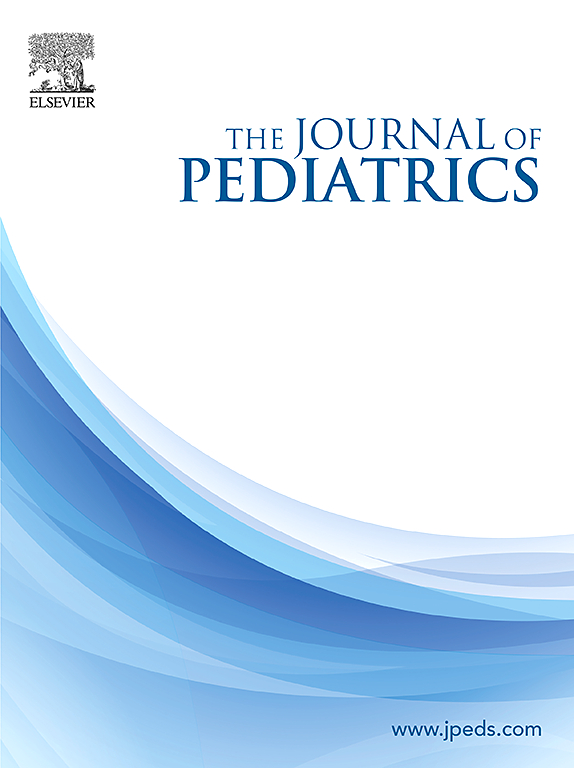Urine Testing in Children with Viral Symptoms: A Nationwide Analysis of Ambulatory Visits, 2014-2019
IF 3.9
2区 医学
Q1 PEDIATRICS
引用次数: 0
Abstract
Objective
To evaluate the extent of and factors associated with urine testing in US pediatric ambulatory visits for symptoms commonly associated with viral illness.
Study design
We analyzed a nationally representative, cross-sectional sample of ambulatory clinic and emergency department (ED) visits among children 2 months to 17 years old (2014 through 2019 National Ambulatory Medical Care Survey and National Hospital Ambulatory Medical Care Survey). Using reason for visit classification codes, we identified visits for respiratory symptoms, diarrhea, or rash; termed “viral symptoms” without reported localizing genitourinary symptoms. We assessed the proportion of these visits with urine testing (urinalysis and/or urine culture) and evaluated factors associated with urine testing using logistic regression.
Results
Of 71.3 million (95% CI 64.7-78.0 million) pediatric ambulatory visits per year, 61% (95% CI 59%-63%) were for viral symptoms without reported genitourinary symptoms. Urine testing at these visits accounted for 38% (95% CI 30%-47%) of overall urine testing. Such testing occurred more frequently at ED visits (8.3%; 95% CI 7.4%-9.3%) compared with clinic visits (4.4%; 95% CI 2.5%-7.7%). At ED visits, the adjusted probability of urine testing in the context of viral symptoms was lowest for males age 2 months to <2 years (5%; 95% CI 3%-6%) and highest for females age 12 through 17 years (20%; 95% CI 16%-24%), and females age 6-11 years (13%; 95% CI 11%-16%).
Conclusions
Urine testing in children with symptoms of viral or other non-urinary tract infection illnesses occurs frequently at ambulatory visits. This potentially avoidable testing disproportionately occurred in older age groups that have lower risk of urinary tract infection.
病毒性症状儿童尿液检测:2014-2019年全国门诊就诊分析
目的:评估美国儿科门诊对病毒性疾病相关症状进行尿检的程度和相关因素。研究设计:我们分析了具有全国代表性的2个月至17岁儿童门诊和急诊科(ED)就诊的横断面样本(2014年至2019年全国门诊医疗调查和全国医院门诊医疗调查)。使用就诊原因分类代码,我们确定了呼吸道症状、腹泻或皮疹的就诊情况;被称为“病毒症状”,没有报道局部泌尿生殖系统症状。我们评估了这些就诊中尿检(尿检和/或尿培养)的比例,并使用logistic回归评估了尿检相关的因素。结果:在每年7130万(95% CI 6470 - 7800万)儿科门诊就诊中,61% (95% CI 59-63%)是因病毒症状而未报告泌尿生殖系统症状。这些就诊的尿检占全部尿检的38% (95% CI 30-47%)。这种检测在急诊科就诊时更为常见(8.3%;95% CI 7.4-9.3%)与门诊就诊(4.4%;95% ci 2.5-7.7%)。在急诊科就诊时,2个月大的男性在病毒症状背景下进行尿检的调整概率最低。结论:在有病毒症状或其他非尿路感染疾病的儿童中,尿检经常在门诊就诊时发生。这种可能可以避免的检测不成比例地发生在尿路感染临床风险较低的老年人群中。
本文章由计算机程序翻译,如有差异,请以英文原文为准。
求助全文
约1分钟内获得全文
求助全文
来源期刊

Journal of Pediatrics
医学-小儿科
CiteScore
6.00
自引率
2.00%
发文量
696
审稿时长
31 days
期刊介绍:
The Journal of Pediatrics is an international peer-reviewed journal that advances pediatric research and serves as a practical guide for pediatricians who manage health and diagnose and treat disorders in infants, children, and adolescents. The Journal publishes original work based on standards of excellence and expert review. The Journal seeks to publish high quality original articles that are immediately applicable to practice (basic science, translational research, evidence-based medicine), brief clinical and laboratory case reports, medical progress, expert commentary, grand rounds, insightful editorials, “classic” physical examinations, and novel insights into clinical and academic pediatric medicine related to every aspect of child health. Published monthly since 1932, The Journal of Pediatrics continues to promote the latest developments in pediatric medicine, child health, policy, and advocacy.
Topics covered in The Journal of Pediatrics include, but are not limited to:
General Pediatrics
Pediatric Subspecialties
Adolescent Medicine
Allergy and Immunology
Cardiology
Critical Care Medicine
Developmental-Behavioral Medicine
Endocrinology
Gastroenterology
Hematology-Oncology
Infectious Diseases
Neonatal-Perinatal Medicine
Nephrology
Neurology
Emergency Medicine
Pulmonology
Rheumatology
Genetics
Ethics
Health Service Research
Pediatric Hospitalist Medicine.
 求助内容:
求助内容: 应助结果提醒方式:
应助结果提醒方式:


